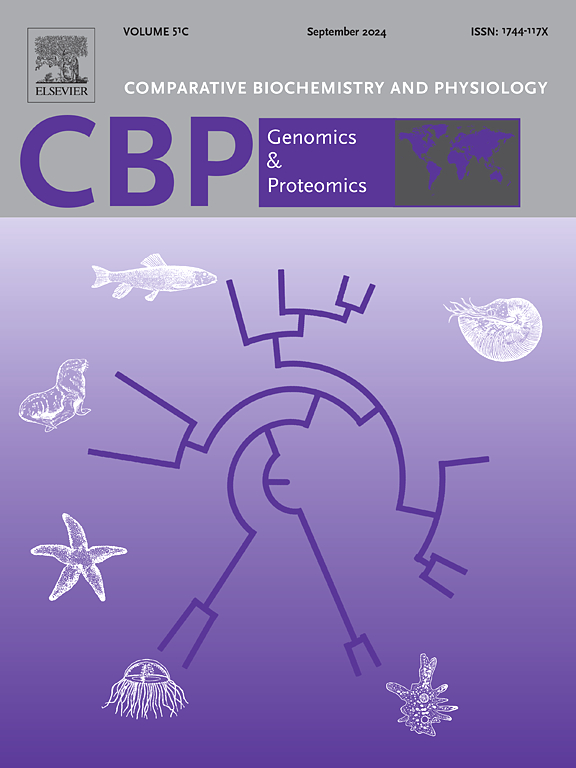渗透胁迫下野生东方牡蛎幼体基因表达可塑性的微地理变异
IF 2.2
2区 生物学
Q4 BIOCHEMISTRY & MOLECULAR BIOLOGY
Comparative Biochemistry and Physiology D-Genomics & Proteomics
Pub Date : 2025-07-09
DOI:10.1016/j.cbd.2025.101577
引用次数: 0
摘要
基因表达可塑性是生理驯化的重要机制。在成年东方牡蛎,Crassostrea virginica (Gmelin, 1791)中,在河口盐度梯度下,不同牡蛎床源对实验渗透胁迫的转录组反应不同。本研究采用RNA-seq技术,对来自特拉华湾上、下游牡蛎养殖场的野生牡蛎贝(幼牡蛎)基因表达可塑性的空间变异进行了表征,并分别暴露于中、低盐度的实验处理中。低盐度条件对该物种的死亡率有显著影响,预计在未来的气候条件下,海湾上游长期低盐度的压力事件将增加频率。在中等盐度(下海湾)地点收集的贝在处理之间的差异表达转录本数量是上海湾的两倍多,这是一种基因表达可塑性的空间变异模式,与之前在成人中发现的结果一致。然而,基因表达可塑性的另一种衡量标准,即处理之间的对数倍表达度差异,在低盐度(上海湾)采集的牡蛎中更大。观察到的基因表达可塑性的空间差异表明,早期定居前或定居后的环境条件可能在单个河口的上游和下游海湾种群之间产生不同的转录组全渗透胁迫响应。本文章由计算机程序翻译,如有差异,请以英文原文为准。

Microgeographic variation in gene expression plasticity under osmotic stress in wild eastern oyster juveniles (Crassostrea virginica)
Gene expression plasticity is an essential mechanism of physiological acclimation. In adult eastern oysters, Crassostrea virginica (Gmelin, 1791), transcriptomic responses to experimental osmotic stress differ between oyster bed sources within the estuarine salinity gradient. Here RNA-seq was used to characterize spatial variation in gene expression plasticity in wild oyster spat (juveniles), collected from upper and lower Delaware Bay oyster beds, and reciprocally exposed to moderate and low salinity experimental treatments. Low salinity conditions contribute significantly to mortality in the species and stressful upper bay episodes of extended hypo-salinity are expected to increase in frequency under future climate conditions. The spat collected at moderate salinity (lower bay) sites show more than twice as many differentially expressed transcripts between treatments, relative to their upper bay counterparts – a pattern of spatial variation in gene expression plasticity consistent with previous findings in adults. However, an alternate measure of gene expression plasticity, the log-fold degree of expression difference between treatments, was greater in oysters collected at low salinity (upper bay). Observed spatial differences in gene expression plasticity indicate that early pre- or post-settlement environmental conditions likely generated distinct transcriptome-wide osmotic stress responses between upper and lower bay populations of a single estuary.
求助全文
通过发布文献求助,成功后即可免费获取论文全文。
去求助
来源期刊
CiteScore
5.10
自引率
3.30%
发文量
69
审稿时长
33 days
期刊介绍:
Comparative Biochemistry & Physiology (CBP) publishes papers in comparative, environmental and evolutionary physiology.
Part D: Genomics and Proteomics (CBPD), focuses on “omics” approaches to physiology, including comparative and functional genomics, metagenomics, transcriptomics, proteomics, metabolomics, and lipidomics. Most studies employ “omics” and/or system biology to test specific hypotheses about molecular and biochemical mechanisms underlying physiological responses to the environment. We encourage papers that address fundamental questions in comparative physiology and biochemistry rather than studies with a focus that is purely technical, methodological or descriptive in nature.

 求助内容:
求助内容: 应助结果提醒方式:
应助结果提醒方式:


